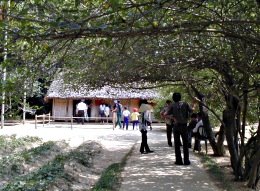Ho Chi Minh's House
 Vinh is about three quarters of the way up Vietnam. It is a city made in the true communist mould: wide boulevards as straight as rulers, aesthetically challenged housing complexes and intermittent billboards exhorting the workers to follow the party line. Now it is all just a substrate, fifteen years of capitalism have done their work in transforming the city center into a hustling, free-wheeling market place. The only reason to come to Vinh in the first place is to visit the nearby village of Kim Lien, the birth place of Ho Chi Minh, Vietnam's beloved father figure. To the Vietnamese he's known as Uncle Ho, or Bac Ho, which does sound a lot like "backhoe". I'm still trying to figure out whether or not the cross-cultural allusion works. Under his aegis the French were defeated and a communist state installed in North Vietnam. Afterwards, until his death in 1969, he lead the fight to reunify the country and rid it of all the troublesome foreigners.
Vinh is about three quarters of the way up Vietnam. It is a city made in the true communist mould: wide boulevards as straight as rulers, aesthetically challenged housing complexes and intermittent billboards exhorting the workers to follow the party line. Now it is all just a substrate, fifteen years of capitalism have done their work in transforming the city center into a hustling, free-wheeling market place. The only reason to come to Vinh in the first place is to visit the nearby village of Kim Lien, the birth place of Ho Chi Minh, Vietnam's beloved father figure. To the Vietnamese he's known as Uncle Ho, or Bac Ho, which does sound a lot like "backhoe". I'm still trying to figure out whether or not the cross-cultural allusion works. Under his aegis the French were defeated and a communist state installed in North Vietnam. Afterwards, until his death in 1969, he lead the fight to reunify the country and rid it of all the troublesome foreigners.To get to Kim Lien I hired a xe om, a motor-cycle taxi. It was a short and, at times, death defying ride through a landscape flattened by paddy fields and bordered by attractive low hills. The village, squat and forgettable, would be just another rice town were it not for its remarkable son.
Ho Chi Minh was born in 1890. The houses in his compound were certainly much younger than that. In the tropical heat the thatched roofs, woven walls and wooden rafters and supports would have rotted away years ago. I got the impression of it being very much like the paradox of "My Grandfather's Axe" in which the speaker states that his father replaced the handle and he replaced the head, but that it is still his "grandfather's axe". There were a few potentially, authentic knick-knacks knocking around, some fossilized books and an ink dish or two, all lovingly preserved in glass cases. All the other furnishings, mat covered wooden beds, a loom and some tables and chairs, were newer and probably made especially for the exhibit. It was difficult to tell as all the information was written exclusively in Vietnamese. A woman asked me in broken English if there was anything I'd like to know about the place. I asked her in which of the houses Ho Chi Minh was born.
"Yes," she answered definitively.
The compound was filled with people eagerly craning their necks to peer into the various rooms. Many of them were children who sported red scarves in the style of the "Young Pioneers". Women tour guides equipped with megaphones and dressed in knee length shirts and baggy pants, the traditional garb for Vietnamese women, herded them from place to place trying to instill in them the magnitude of their present location. By and large the children found the big nosed foreigner infinitely more interesting. Even the adults couldn't resist nudging one another and pointing in my direction. At the flower strewn altar to Bac Ho, one of them insisted on having his picture taken with me.
 The square outside the compound, where the tour buses park, is bordered by souvenir shops. Here the faithful can buy all the Bac Ho paraphernalia their wallets can afford, from slim volumes of his works to green plastic busts that probably glow in the dark. My personal favorite was the Bac Ho clock with a halo of lights forever jetting out of his whispy, bearded head.
The square outside the compound, where the tour buses park, is bordered by souvenir shops. Here the faithful can buy all the Bac Ho paraphernalia their wallets can afford, from slim volumes of his works to green plastic busts that probably glow in the dark. My personal favorite was the Bac Ho clock with a halo of lights forever jetting out of his whispy, bearded head.


1 Comments:
Haa haa. Nelson
Post a Comment
<< Home